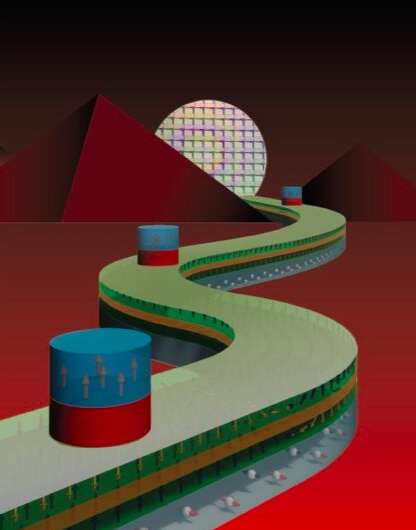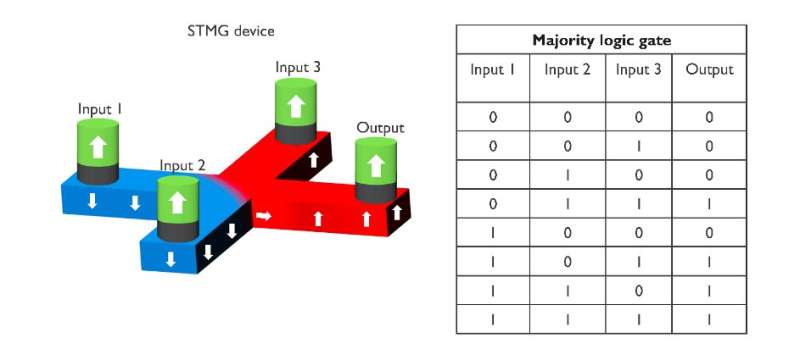July 23, 2021 feature
The electrical control of domain wall devices based on perpendicular magnetic tunnel junctions

Domain walls (DWs) are boundaries between two neighboring magnetic domains. The electrical manipulation of these boundaries in nanostructures could ultimately lead to the development of new computing systems to store and process information.
Researchers at IMEC in Belgium have recently developed new DW devices with perpendicular magnetic tunnel junction (MTJs) as write/read components. The devices, presented in a paper published in Nature Electronics, consist of multiple MTJs magnetically interconnected by a nanotrack. The write/read components could achieve performances comparable to those of existing magnetic random-access memory technology, while the fast DW motion between MTJs can be controlled by spin orbit torque.
"In DW-based devices, input information is encoded into a magnetic domain in a magnetic track and the device is then operated using the motion of DWs along the magnetic track," Van Dai Nguyen, a researcher at IMEC who led the study, told TechXplore. "The key feature of these devices is that the motion of DWs can be transported in an arbitrary form of a magnetic track."
Over the past few years, electronics engineers developed a variety of different DW-based devices with ultra-high storage densities, low power consumption and flexible designs. These include racetrack memory, spin logic and neuromorphic computing devices.
DW devices generally have three main components, each with a specific function. The first is responsible of generating DWs onto magnetic tracks (i.e., the writing process), the second of transporting DWs from the input to the output along the DW conduit layer (i.e., the transporting process), and the last of using the output to detect the arrival of a DW (i.e., the reading process).
"Over the past decade, research mainly focused on exploring novel physical mechanisms in different materials to enable fast DW motion," Eline Raymenants, a Ph.D. candidate at IMEC who carried out the study said. "These discoveries have offered various options in term of materials for the DW conduit layer in high-performance devices. However, so far, a complete functional DW device has not been experimentally demonstrated at nanoscale."
Although many engineers, especially experts in the area of spintronics, have been theoretically exploring the potential of DW devices, so far these devices' practical realization has proved to be highly challenging. A key reason for this is that researchers currently lack the electrical means to read and write DWs at the nanoscale.
Nguyen and his colleagues were able to overcome these limitations by realizing fully operating DW devices based on perpendicular MTJs with electrical reading and writing capabilities, as well as fast DW motion via spin-orbit torque. The demonstration of all-electrical control in their nanoscale DW device could pave the way toward the development of new DW devices that reach beyond CMOS spin logic, racetrack memory and neuromorphic computing devices.

Most existing methods for reading and writing DWs are based on the use of external magnetic fields or on conventional MTJs, which are not compatible with high-speed DW motion. Devices fabricated using these methods also have limitations associated with the etch patterning steps of their manufacturing processes.
"To overcome these challenges, we developed a hybrid free layer MTJ stack in which a second free layer for DW transport is incorporated into the conventional MTJ stack," Nguyen said. "Our DW device based on hybrid free layer design simultaneously benefits from the energy-efficient write and read processes of current magnetic random access memory technology and from fast DW motion in the separate DW conduit layer."
The unique design devised by Nguyen and his colleagues allowed them to independently optimize materials for fast DW transport, while also reducing their sensitivity to process-induced damage when integrated on devices on a large scale. Theoretically, this approach could enable the integration of any material with high DW speed in the DW conduit layer into high-performance DW devices, including both ferromagnetic materials and synthetic antiferromagnetic materials or ferrimagnets.
"As an example, we demonstrated that a DW conduit based on a synthetic antiferromagnet offers the potential for reliable DW motion and faster write speed compared to its ferromagnet counterpart," Raymenants said. "We also showed that our devices offer the possibility to explore the physics of DW dynamics in operation mode at nanoscale, where current magnetic imaging techniques become ineffective in fully integrated devices at low dimensions."
The findings gathered by the team of researchers at IMEC and their collaborators at Université Paris-Saclay and Intel Corporation could enhance the current understanding of DW devices, while also enabling the development of more advanced technologies based on advanced DW conduit materials. Remarkably, the hybrid DW device design they proposed could aid the practical realization of both DW-based devices and other spintronic devices, including skyrmion and spin-wave based devices.
The devices that Raymenants and co-authors presented in their paper were fabricated using IMEC's 300 mm CMOS fab on full wafers. This means that they are fairly easy to reproduce and are highly compatible with other existing electronic components.
So far, the researchers have only used their design to demonstrate the most basic operation of a fully functional DW device. Therefore, there is still a long way to go before their device can be implemented and tested for real-world applications.
As a next step, Nguyen and his colleagues will try to use their design to create a spin torque majority gate device, enabling functional rather than dimensional scaling. Spin torque majority gate devices have been found to be highly promising, as they could improve energy efficiencies by reducing the complexity of logic circuits. This work is currently supported by Intel Corporation's Beyond CMOS program.
"The simplest version of majority gates has three inputs and one output," Nguyen said. "The output turns to 'true' if more than 50% of the inputs is 'true," a democratic spin logic device. In the spin torque majority gate proposal, the majority of DWs generated at each input magnetic tunnel junction will merge in the DW conduit layer and propagate to the output magnetic tunnel junction to be read by tunneling magnetoresistance."
More information: Nanoscale domain wall devices with magnetic tunnel junction read and write. Nature Electronics(2021). DOI: 10.1038/s41928-021-00593-x
© 2021 Science X Network





















